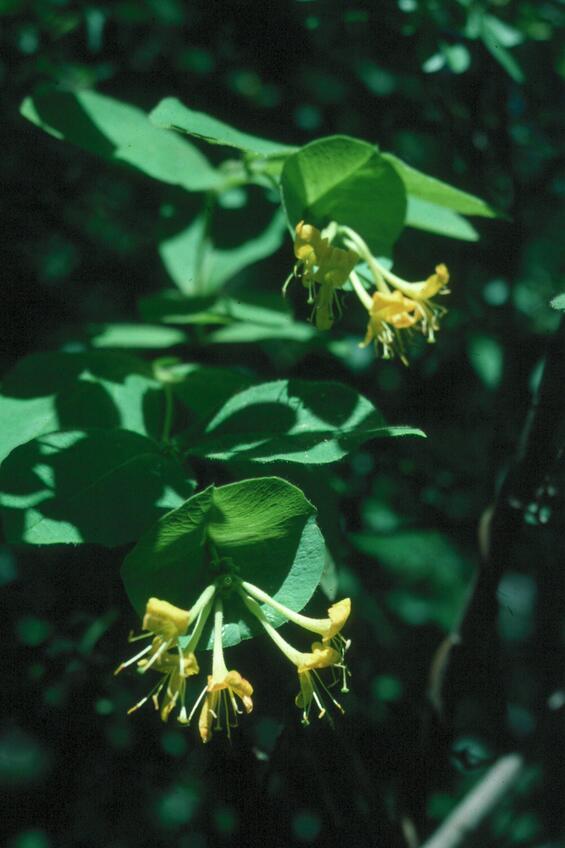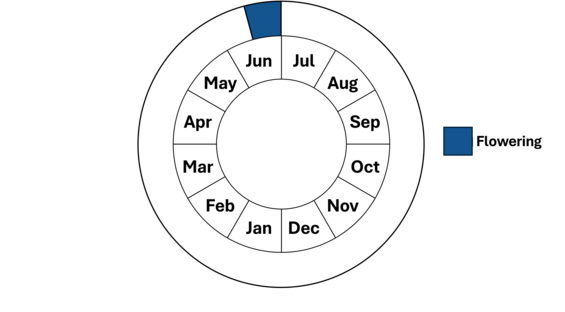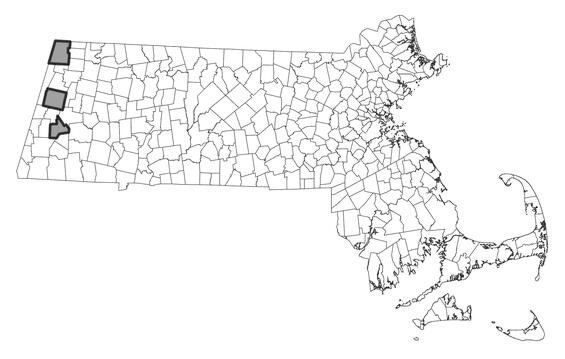- Scientific name: Lonicera hirsuta Eaton
- Species of Greatest Conservation Need (MA State Wildlife Action Plan)
- Endangered (MA Endangered Species Act)
Description

Hairy honeysuckle, Lonicera hirsuta, is a twining and climbing, somewhat shrubby vine that may reach 3 m (10 ft) high in the honeysuckle family (Caprifoliaceae). The young stems of this plant are very hairy and glandular. The dull green leaves are 6-12 cm (2.5-4.75 in) long and 3-8 cm (1.2-3.2 in) wide. The leaf blades are broadly tapered almost equally at both ends and are more or less hairy on both sides. The upper one or two leaf pairs unite at their bases to form a roundish disc with rather pointed tips. One to four sticky-hairy, yellow flowers are arranged in a whorl on a stalk just above the uppermost leaf pair. These attractive, 2.5 cm (1 in) long flowers are two-lipped with the lower lip divided into four lobes.
Wild honeysuckle (L. dioica) is also vine-like but has longer (5-12 cm; 2.0–4.7 in) leaves than hairy honeysuckle and flowers are pale yellowish-purple. Moreover, the whole plant is hairless and leaves are whitened (glaucous) beneath. Other honeysuckles likely to occur with hairy honeysuckle are bushy shrubs with many stems.
Life cycle and behavior
The tube of each flower is slightly swollen near the base. Flowering season is from mid- to late June. The fruit is a cluster of red berries.

Population status
The Massachusetts Natural Heritage & Endangered Species Program has 4 records from Berkshire County. Three of these records have been verified since 1999.
Distribution and abundance
Hairy honeysuckle is found from southwestern Quebec and western New England to western Ontario and Minnesota, south to Pennsylvania, Michigan, and Wisconsin.

Distribution in Massachusetts. 2000-2025. Based on records in the Natural Heritage Database.
Habitat
Hairy honeysuckle is found in open to lightly shaded exposures on calcareous rocky slopes or acidic slopes with calcareous till. This vine may be found under white ash, European buckthorn, white birch, basswood, black cherry, red oak, sugar maple, red maple, black locust, witch hazel, hazelnut, sassafras, or flowering dogwood. Surrounding plants may include round-leaved dogwood (Cornus rugosa), sedge (Carex eburnea), hazelnut (Corylus americana), Morrow honeysuckle (Lonicera morrowii), wild honeysuckle (Lonicera dioica), and meadow rue (Thalictrum dioicum). All Massachusetts populations occur at sites which have been disturbed in the past.
Healthy habitats are vital for supporting native wildlife and plants. Explore habitats and learn about conservation and restoration in Massachusetts.
Threats
Reasons for hairy honeysuckle’s rarity include loss of habitat through human development, grazing and forest succession. There are few suitable habitats. Competition and loss of light from morrow honeysuckle, a pernicious and aggressive alien shrub, also threatens this species. Hairy honeysuckle is also impacted by leaf miners and is heavily browsed by deer. Another issue is that hairy honeysuckle is self-incompatible and populations that are too small and closely related may not successfully reproduce.
Conservation
Surveys for this species must be based on the vegetative characteristics, as the current populations rarely flower. It can be surveyed for from May through August.
Management for this species currently includes controlling invasive plants in one population and installation of a deer exclusion fencing. Protection of the current known population sites for hairy honeysuckle has already occurred.
Research for hairy honeysuckle is needed to understand its ecological needs better. Despite efforts to increase the populations of the species, we have only observed decreases. It is not known if prescribed fire may help the populations as it is suspected that fire previously did occur in the two largest of the state’s current populations.
Contact
| Date published: | April 30, 2025 |
|---|